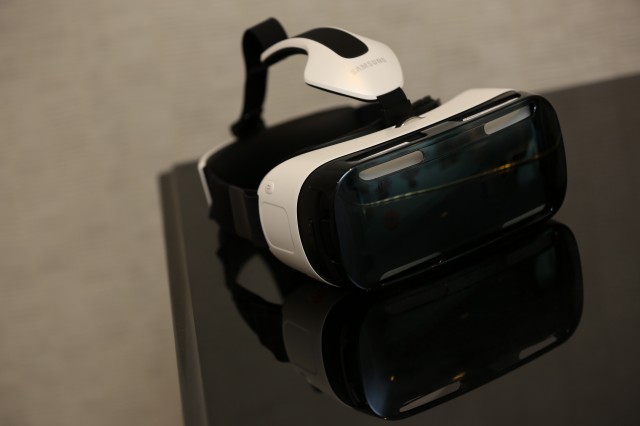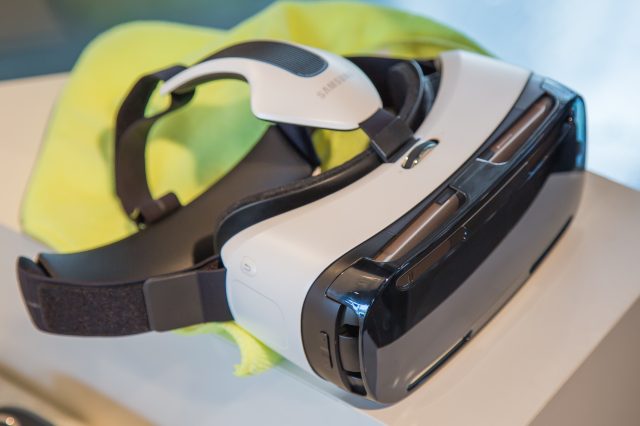
Over the last few years, I've tried a number of virtual reality "solutions" that involve popping a smartphone into some sort of mask that straps to your face. On the surface, it seems like a natural fit to use a phone as a combination virtual reality display, head-tilt sensor, and processor that avoids the need to tether to a bulky PC tower.
Unfortunately, every one of the prototype phone-based VR devices I'd tried delivered an on-the-cheap virtual reality experience that ranged from awful to mediocre. Issues with optics, frame rate, and accurate head tracking have plagued all of these efforts to the extent that I began to think modern cell phones just weren't up to the task of driving convincing virtual reality.
Thus, I was a bit skeptical of Gear VR, Samsung's recently announced hardware effort that turns the upcoming Galaxy Note 4 smartphone into a VR headset using a holster powered by Rift maker Oculus. The middling hands-on experience with Gear VR reported by our own Ron Amadeo earlier this month didn't really change my impressions, either.
Perhaps because of those low expectations, I came away from my extensive demo time with the Gear VR at this weekend's Oculus Connect conference impressed by the quality of the virtual reality experience on offer. While there are still some issues, Gear VR seems poised to prove that top-of-the-line cell phones can provide "good enough" virtual reality at a relatively cheap cost and on a relatively short time scale.
Is this really a cell phone?

As someone who has logged dozens of hours on Oculus Rift development kits and prototypes, I was immediately struck by how much more comfortable the Gear VR was on my face. It lacks the thick, heavy cable that can weigh a device down and throw it off balance. The rigid, cushioned straps on the top and back of the device allowed for nice support without forcing the screen too tightly against my face, as the Rift dev kits do. The device didn't seem overly heavy, and I was able to wear it for an entire hour without feeling any pressure to take it off (except to occasionally scratch a facial itch underneath the device).
One big leg up Gear VR has over previous phone-based virtual reality systems—and even over current Oculus development kits—is its impressive resolution. The 1440p, 515 PPI display on the Galaxy Note 4 doesn't totally do away with the problem of visible pixels, but it's above or equal to most any other consumer-grade VR product on the horizon.
The black-lined "screen door" effect between individual pixels is minimized on a screen of this resolution, though there are still some issues of color bleeding and warping if you focus tightly on individual pixels. A set of lenses in the headset itself make for a convincing, eyestrain-free 3D effect that extends for an impressive 96-degree field-of-view, which is actually a bit wider than what you might be used to on an Oculus dev kit.
The 3D environments rendered in Gear VR demos obviously can't hold a candle to those generated by a high-end PC tower with a modern graphics card. That said, the Galaxy Note 4 seems powerful enough to generate 3D environments with a level of detail along the lines of a late PlayStation 2- or early PlayStation 3-era game, as long as the scenes aren't too crowded. The improved resolution goes a long way to making these scenes pop, even if they're less detailed than the kind you would get on a top-of-the-line tethered computer.
Gear VR also offers the kind of smooth, jutter-free screen refreshing that you just have no right to expect from cell phone hardware. Samsung and Oculus are advertising latency of less than 20 milliseconds between the time you move your head and the time the scene updates on Gear VR, thanks in part to additional head-tracking hardware in the holster itself.
At the conference, Oculus CTO John Carmack talked in detail about his efforts to get Samsung to modify the phone itself to allow for faster screen refresh rates and to develop a predictive tracking model, called asynchronous time warp, that reduces apparent latency from movement to visuals. Technical details aside, the result is a virtual world that feels rock solid around you. It makes you feel less like you're staring at a tiny cell phone screen and more like you're on the inside of a giant fishbowl that surrounds your head with a solid 3D display that extends in every direction as you look around.
Keep that head still

The only thing that really breaks this immersion is the lack of any lateral head tracking on the Gear VR. Unlike the Rift DK2, which uses an external camera to figure out when your head changes position, Gear VR has no way to account for any head movements, aside from angular direction. Very quickly, you learn not to lean in to look more closely at a virtual object unless you want to feel your stomach drop.
Thus, most of the Gear VR demos on display at the conference took place from a stationary position that didn't require any virtual movement outside of tilting your neck. There were more than a few games in the "turret shooter" category asking you to turn your head to aim a cannon, slingshot, or laser at a vast 3D field in front of you (the single button on the side of the device, which you could tap for a "click" effect was particularly useful in these). Many other demos were barely interactive at all, such as Harmonix's trippy Rekall music visualizer, visual astronomy textbook Titans of Space, undersea voyage Ocean Rift, and a 3D video of a Cirque du Soleil performance.
Other demos turned the player into his own third-person camera, positioned above an interactive 3D world below. Games like Bombsquad, Quest VR, and Lucky's Playground made me feel like a god looking down on a toy box full of tiny, living playthings. Still others used the head-tracking as a form of control; in Escape Velocity, the viewpoint follows closely behind a spaceship whose movement and aim tracks along with the reticle that moves along with your viewpoint (Asteroids-esque 2D shooter MinoVR did something similar, but with worse results).
The few demos that did allow for movement usually did so indirectly. In DeNA's stealth shooter Protocol Zero and UsTwo's Land's End, players could look around freely as the game slowly moved them between preset points that were selected with a glance and a tap. The movements were gentle and smooth enough to prevent any motion sickness, but it was also a little frustrating to float through the environments so lazily without any direct control.
The one demo that gave true first-person 3D control, dungeon-crawler Deadhalls, is an invitation to nausea-town unless you hold your head perfectly still as you move forward—though it was particularly nice being able to turn a full 360 degrees in the game without getting tangled up in a cable.
For those looking for the best quality VR experience, the Gear VR seems likely to be a mere stopgap on the path to the eventual consumer version of the Oculus Rift. Gear VR will likely be available in a matter of months, and only for a few hundred dollars on top of a cell phone you might want anyway. It seems more than good enough to provide a solid, proof-of-concept virtual reality experience that will be easy to show off to friends.
Listing image by Oculus
reader comments
47